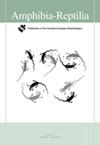遥感和公民科学表征一种地方病和濒危哥斯达黎加毒蛙的生态位
IF 1.3
4区 生物学
Q3 ZOOLOGY
引用次数: 0
摘要
栖息地的侵占会对生物多样性造成毁灭性的影响,尤其是两栖动物。vittatus是哥斯达黎加的一种地方性青蛙,近几十年来,哥斯达黎加的土地覆盖发生了重大变化。在这里,我们利用遥感创建了该地区的土地覆盖图,并进行了生态位建模,以确定与该物种分布相关的主要非生物因素。我们根据自己的实地观察、其他研究人员的观察和公民科学参与者的观察,为我们的模型提供信息,以获得vittatus发生的综合数据库。海拔高度、森林覆盖率、与湖泊和河流的距离、年温差和降水等因素影响了维塔图的生态位,维塔图的生态位主要分布在保护区内。对物种栖息地的先验知识是解释模型输出的关键。我们确定了可能被隔离的种群,以及尚未证实存在或尚未被物种占领的区域,从而确定了重新引入的潜在区域。我们还计算了占用面积,并建议将P. vittatus的状态调整为“濒危”。未来对种群健康和连通性的调查和评估将有助于更好地确保该物种的长期保护。本文章由计算机程序翻译,如有差异,请以英文原文为准。
Remote sensing and citizen science to characterize the ecological niche of an endemic and endangered Costa Rican poison frog
Habitat encroachment can have devastating effects upon biodiversity, especially amphibians. Phyllobates vittatus is an endemic frog from Costa Rica, where land cover has seen significant changes over recent decades. Here we use remote sensing to create a land cover map of the region and carry out ecological niche modelling to identify the main abiotic factors associated to the distribution of this species. We have informed our models based on our own field observations, those from other researchers, and citizen science participants to obtain a comprehensive database of P. vittatus occurrences. Elevation, forest percentage, distance to lakes and rivers, annual temperature range and precipitation variables were found to shape the ecological niche of P. vittatus, which is mostly located within protected areas. Prior knowledge of the habitat of the species was key to interpret the model output. We identify populations that might be isolated, and areas where presence has not yet been verified or that have not been occupied by the species, thus, identifying potential areas for reintroductions. We also calculated the area of occupancy and recommend that P. vittatus’ status be adjusted to “Endangered”. Future surveys and evaluation of population health and connectivity would help to better ensure the protection of the species in the long-term.
求助全文
通过发布文献求助,成功后即可免费获取论文全文。
去求助
来源期刊

Amphibia-Reptilia
生物-动物学
CiteScore
3.10
自引率
6.20%
发文量
39
审稿时长
6-12 weeks
期刊介绍:
Amphibia-Reptilia is a leading European multi-disciplinary journal devoted to most of the aspects of herpetology: ecology, behaviour, evolution, conservation, physiology, morphology, paleontology, genetics, and systematics.
Amphibia-Reptilia publishes high quality original papers, short-notes, reviews, book reviews and news of the Societas Europaea Herpetologica (SEH). The Societas Europaea Herpteologica (SEH) website is located at: www.seh-herpetology.org.
 求助内容:
求助内容: 应助结果提醒方式:
应助结果提醒方式:


